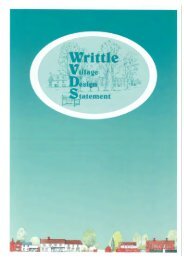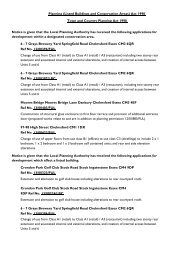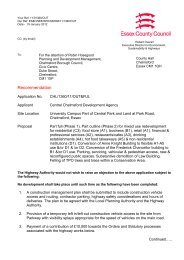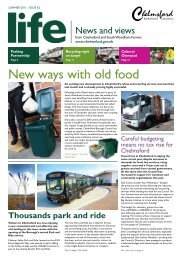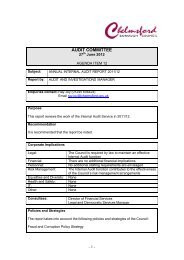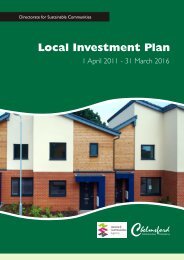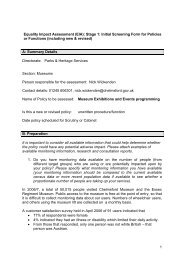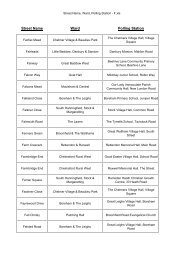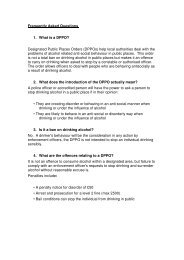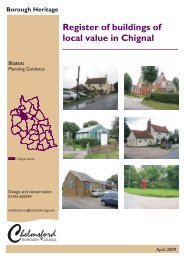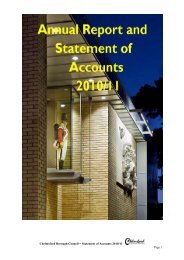Landscape Character Assessment - Chelmsford Borough Council
Landscape Character Assessment - Chelmsford Borough Council
Landscape Character Assessment - Chelmsford Borough Council
You also want an ePaper? Increase the reach of your titles
YUMPU automatically turns print PDFs into web optimized ePapers that Google loves.
122.2.8 On the hills above the London Clay, the capping of the fine sands of the Bagshot Beds by thepebbly clay drifts have led to acidic soils with low natural fertility that are easily cultivated.2.2.9 In the northwest of the Study Area, the geology changes to glacial tills composed of sandsand gravels overlain by the most extensive soils in the area, pelosols. These are heavy acidicsoils often prone to waterlogging in winter months and to shrinking and cracking in summerresulting in a predominance of pasture fields on the low hills and ridges.2.2.10 In the northwest of Uttlesford, the altitude reaches just over 130m AOD to the west ofSaffron Walden. In this area the chalk is exposed at the surface and has given the area itscharacteristic rolling topography and free draining poor alkaline soils that support widespreadcereal farming.2.2.11 The Study Area has a large intricate network of rivers and streams. These are an importantcomponent of the area’s topography, character and identity and are frequently of landscape,nature conservation and heritage value. To the north the valleys become steeper and moredeeply cut.2.2.12 Most of the rivers flow towards either the Thames or the North Sea (see Figure 2.2). Onlythe Cam flows northward. Principal rivers within the Study Area are the Stour, Colne,Blackwater, Chelmer and Crouch. The Colne, Blackwater, Chelmer and tributaries rise in theplateau to the north and flow south where their estuaries are extensive and contribute to thedeeply indented coastline. The Crouch flows east across the undulating lowland to the southof the plateau and when joined by the Roach forms an estuary complex that includes theislands of Wallasea, Potton and Foulness.2.2.13 The coastline is mainly marshland and is characterised by a maze of winding shallow creeks,drowned estuaries, mudflats and broad tracts of tidal salt-marsh with sand and shinglebeaches along the coast edge. The relatively permanent, branching, meandering creeks,dissect the salt marshes.Landcover and Ecological <strong>Character</strong>2.2.14 The rural landscape of the Study Area is predominantly used for arable or improved pasture,particularly on the flat or gently undulating land. The rich soils are intensively cultivated andlarge cereal fields are a major feature of the landscape. The cereal field margins occasionallysupport uncommon plants such as cornflower, broad-leaved cudweed, corn cleavers andshepherd’s needle.2.2.15 There are significant areas of remaining semi-natural habitat that make an importantcontribution to the area’s distinctive character. The presence and distribution of thesehabitats is strongly influenced by geology and landform, and include woodland, grassland,heath, estuary, saltmarsh and mudflat and freshwater and open water habitats. Many siteswhere these habitats occur are designated as Ramsar Sites, candidate Special Areas ofConservation (cSAC), Sites of Special Scientific Interest (SSSI), Sites of Importance forNature Conservation (SINCs) 1 , Special Protection Areas (SPA), National Nature Reserves(NNR) and/or Local Nature Reserves (LNR). The distribution of these areas designated fortheir nature conservation value are shown on Figure 2.3 and described below in relation tokey habitat types.1 SINCs are also referred to as County Wildlife Sties, which will become known as Local Wildlife Sites in duecourse.Section 2.0 – Overview of the Study Area11100101R Final LCAs_09-06



